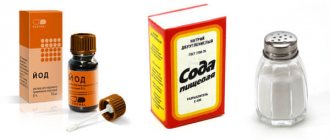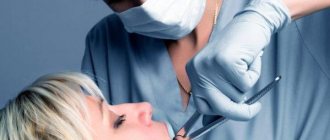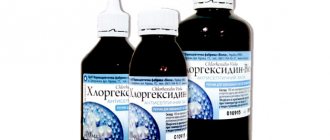What is Chlorhexidine used for?
An aqueous solution is prescribed to be taken in the following cases:
- cervical erosion;
- for the prevention of syphilis, genital herpes and other vaginal diseases;
- disinfection of dentures, disinfection of wounds;
- various diseases of the oral cavity.
An alcohol solution is used to treat hands and medical devices before surgery. The solution is also used to treat the working surface of medical equipment.
Vaginal suppositories are effective for the following conditions:
- in order to prevent infections that can be transmitted as a result of unprotected sexual intercourse;
- bacterial vaginosis;
- prevention of inflammation and infections before surgery, childbirth or abortion.
Instructions: how to take and can you rinse your mouth and throat?
Below is the answer to the question whether it is possible to use chlorhexidine to gargle or rinse your nose with this drug. Chlorhexidine is safe during gestation if used only for the following procedures:
- Baths for the oral cavity. 20 ml. the drug (0.05%) must be taken into the mouth and held for 30 - 60 seconds, after which it must be spat out and the mouth must not be rinsed. The procedure should be repeated twice a day for 7 – 10 days.
- Rinsing the mouth and throat. 1 tablespoon of a 0.05% solution of the medication is taken into the mouth, and rinsed for a minute or two. Upon completion of the procedure, it is not recommended to eat for 1 hour after rinsing. The course of treatment is 3 – 5 times a day for a week.
- Nasal rinsing. This manipulation is performed using a 0.05% drug diluted with saline in a 1:1 ratio. You need to sit comfortably and inject the medicine into each nostril so that it flows calmly out of the other nostril without getting into the throat.
The procedure should be repeated several times. Treatment regimen: 2 times a day for 7 days.Important requirement: before starting the procedure, it is necessary to clean the mouth or nose by rinsing or washing with chamomile or sage infusion.
And Chlorhexidine must be slightly warmed up by holding the container with the medication in your hands for some time: in a warm state, the drug will have the maximum beneficial effect.
How to use Chlorhexidine in gynecology
The product is actively used to prevent sexually transmitted diseases. No later than 2 hours after unprotected intercourse, you need to take the solution. Men will need to insert 2 ml into the urinary canal, and women will need to insert 2 ml into the urinary canal and another 5-7 ml into the vagina. It is recommended to wipe the skin around the genitals with the solution. The instructions say that after using the drug you need to wait 2 hours before urinating. Otherwise, the effect of use will be less.
For preventive purposes, vaginal suppositories can be used.
Before using the product for thrush and other gynecological pathologies, you should consult a specialist in advance.
Can pregnant women take it?
During pregnancy, Chlorhexidine is only suitable for external use.
Therefore, a solution for rinsing, irrigation, and washing the ENT organs becomes especially relevant during the period of bearing a child. Although the drug is considered safe for mother and child, it can only be used after consulting a doctor. Some sources indicate that such a drug can also be used for douching in pregnant women in the case of various pathologies of the genital organs. But the douching procedure itself is contraindicated during gestation or should be performed only in the manipulation room by a medical institution employee.
In case of urgent need, it can be replaced by using intravaginal Chlorhexidine suppositories or self-made tampons soaked in a solution of this drug.
In 1st trimester
Perhaps the most crucial period in pregnancy is the 1st trimester , since it is at this time that the baby and the protective placenta are formed, and all vital organs and systems are formed.
Therefore, despite the safety of the drug, it should be used only after consultation with the doctor.
In the 2nd trimester
During this period, the already formed embryo begins to develop, it is already reliably protected by the placenta, so any external influence is not so scary for it. But still, in order to avoid possible risks, it is better to consult a doctor about the advisability of using the drug.
In the later stages
The medication has no effect on the uterus and cannot provoke premature birth.
On the contrary, the drug is actively used in the prenatal period for the sanitation of the birth canal and after (for the treatment of cracks and tears in the perineum).
Contraindications and adverse reactions
Taking the drug is contraindicated in the following cases:
- increased susceptibility to the components included in the composition;
- patients with dermatitis;
- simultaneous use with other antiseptics, for example, hydrogen peroxide;
- in ophthalmology for washing the eyes.
It is better to refrain from using the product to disinfect the surgical field before or after surgery on the central nervous system and auditory canal.
In pediatrics, the drug is used with great caution.
Some patients may experience undesirable reactions such as:
- dry skin;
- allergic skin rashes;
- itching of the skin;
- light sensitivity.
With prolonged use of the product in dentistry, changes in taste may occur, tartar may appear, or teeth may become stained.
Chlorhexidine Pharmland, solution for external use 0.5 mg/ml
In patients with open traumatic brain injury, spinal cord injuries, or perforation of the eardrum, contact with the surface of the brain, meninges, and the cavity of the inner ear should be avoided.
In case of contact with the mucous membranes of the eyes, they should be quickly and thoroughly rinsed with water.
Contact of hypochlorite bleaches on fabrics that have previously been in contact with chlorhexidine-containing medications may cause brown stains.
Use Chlorhexidine Pharmland with caution in conditions where the systemic effect may be dangerous, especially in children, if the skin is damaged over large areas.
Special precautions. Given the lack of information on transdermal absorption, systemic effects cannot be ruled out. The likelihood of their occurrence increases with repeated applications, especially when a large area is treated, the surface under an occlusive dressing or mucous membranes, in the presence of damage to the skin (in particular burns), as well as in the case of treating the skin of newborns (taking into account the ratio of the surface area and body weight of the child and occlusive effect of diapers).
The use of chlorhexidine solution in newborns as a skin antiseptic before invasive procedures is associated with a certain risk of developing a chemical burn. Based on spontaneous reporting and literature data, a higher risk of skin reactions has been identified in preterm neonates, particularly those born before 32 weeks of gestation, in whom chlorhexidine was used during the first two weeks of life.
Before performing invasive procedures, it is necessary to remove all materials soaked in chlorhexidine: bandages, sheets, napkins, gowns, etc. Do not use excessive amounts of solution. The solution should not be allowed to accumulate in skin folds, under the patient’s body, or on materials that are in direct contact with the child’s skin.
If an airtight dressing (occlusive dressing) is to be applied to skin that has previously been exposed to chlorhexidine, ensure that there is no excess chlorhexidine solution on the skin before applying the dressing.
After opening the polymer container, there is a risk of microbial contamination of the drug.
Overdose and interaction with other drugs
Until now, cases of Chlorhexidine overdose have not been reported in medical practice. However, it is always necessary to adhere to the dosages specified in the instructions or selected by a specialist. Also, you should not use the drug for longer than the prescribed course.
Regarding the simultaneous use of Chlorhexidine with other medications, it is prohibited to use the drug with:
- iodine-containing products;
- products containing saponins, sodium lauryl sulfate, sulfonic acid.
The benefits of sea water for the treatment and prevention of runny nose
Sea water has a similar composition to our body fluids. Rinsing the nose with solutions based on sea salt does not cause any discomfort. Sea water contains a whole range of useful microelements: sodium, magnesium, calcium, potassium and others. Due to its rich natural composition, this solution has a number of advantages:
- physical cleaning of the nasal surface from bacteria, viruses and allergens (minimizing allergies);
- natural antiseptic – the negative manifestation of the inflammatory process is reduced, the spread of infection is prevented;
- stimulation of blood circulation - blood flow optimizes the functioning of cells that provide a protective function;
- anti-inflammatory effect;
- rapid healing of damaged mucous membrane;
- strengthening local immunity.
A saline solution for rinsing the nose for pregnant women is the main effective way to combat colds and runny nose at home.
In what cases is it prescribed for pregnant women?
Chlorhexidine is allowed during pregnancy even in the early stages. The drug is not absorbed into the general bloodstream, as a result of which it does not have a negative effect on the fetus or the health of the expectant mother. Despite the wide scope of application, the following indications are distinguished for which the drug is prescribed during pregnancy:
- thrush;
- inflammatory process affecting the vulva and vagina;
- sexually transmitted infectious diseases;
- diseases that cause a sharp increase in pathogenic microflora.
Suppositories or douching with a solution are prescribed before childbirth so that the baby does not become infected after passing through the birth canal. Gargling is also not contraindicated and is effective for stomatitis, inflammation of the nasopharynx of various origins, and ENT diseases.
Composition and release form
Chlorhexidine can be used externally, as a gargle, for douching, or as a vaginal suppository. It interacts well with the skin and mucous membranes without being absorbed into the gastrointestinal tract. The drug destroys fungi, viral infections, gram-positive and negative bacteria (including yeast, dermatophytes and round bacteria), and representatives of the coccal flora.
The main active ingredient of the drug is bigluconate (16 or 20%). The composition of vaginal suppositories additionally includes macrogol. Forms of release of the drug:
- gel;
- solution;
- pills;
- candles;
- ointment;
- spray and aerosol;
- patch.
Are there any contraindications?
Despite its universal nature, the absence of negative effects on the fetus and side effects, Chlorhexidine, in accordance with the instructions for use, also has contraindications:
- inflammation of the skin (for example, dermatitis) - in this case, treatment with the drug is impossible;
- hypersensitivity to components - a similar condition is often observed in pregnant women;
- simultaneous use with other antiseptics or medications that contain iodine;
- too young;
- period of menstruation.
Treatment of the conjunctiva with Chlorhexidine solution is prohibited. It should be remembered that self-medication, especially during pregnancy, is prohibited.
What side effects may occur?
Possible side effects that may occur after using Chlorhexidine include the following:
- skin rash;
- specific temporary color of the tongue and teeth;
- distortion of taste, which is usually due to the bitterness of the rinse solution;
- itching in the vagina;
- burning sensation in the throat.
However, all these side effects are quite rare and are usually associated with long-term use of the drug. Possible associated symptoms:
- sleep disturbance;
- dry mouth;
- sticky palm effect;
- unpleasant taste;
- headache.
Analogs
How can you gargle instead of Chlorhexidine during pregnancy? The pharmaceutical industry produces substances that can replace Chlorhexidine solution if it is not available in the pharmacy, and also if there are cases of hypersensitivity to the drug in the anamnesis, because during pregnancy you should not risk your health.
Analogs of this drug include:
- Miramistin.
- Furacilin.
- Rotokan.
- Chlorophyllipt.
- Pharmaseptic.
The listed medications have different active ingredients from Chlorhexidine. According to indications, they are used as antiseptics and anti-inflammatory medications.
It is not for nothing that Chlorhexidine is considered a universal remedy, since it has been widely used in many branches of medicine. For rinsing the mouth, rinsing the throat, and also for douching the genitals, Chlorhexidine during pregnancy is used only in the form of a low-concentrated aqueous solution.
Author: Violeta Kudryavtseva, doctor, especially for Mama66.ru











